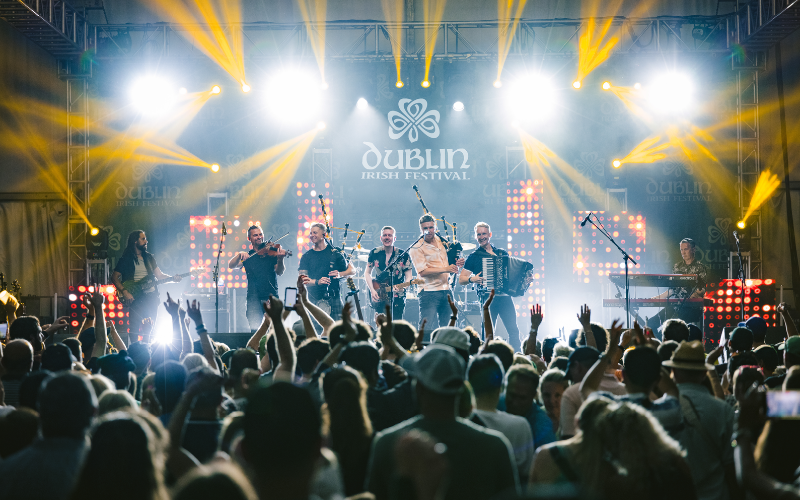When Irish America first published a story on the Irish dance phenomena in America in 1995, the scenes at feisanna were quite different than the chaotic sea of wigs and glitter one might find today. Little girls wore simpler dresses adorned with embroidery in the shapes of Celtic knots, with matching headbands holding back their natural ringlets of hair.
Enter the new millennium and the style of Irish dance twisted the traditional garb into a catwalk of multi-thousand dollar dresses equipped with glimmering rhinestones and the occasional feathers. Top it all off with those infamous and equally ridiculous wigs and you have the sorry spectacle that is competitive Irish dance fashion.
A once time-honored tradition has digressed into a parade of overly made-up children in glittering pageantry. Feisanna are now attracting new over-the-top trends that makes one ask whether the competitions are centered on dance ability or dress-up. Little girls await their competition results with tears streaking their fake tanner and mascara running down their unnaturally rosy cheeks, as mothers and teachers tweak the girls’ wigs and tiaras. And while the boys still wear a shirt, tie and often a broach, the girls arrive in neon-colored dresses and with faces painted like dolls.
The sight of all these little orange girls with manes of faux-ringlets begs the question of where did these “traditions” came from? The Internet has been abuzz in recent years, with parents blogging about the frightening costs and absurd wigs that caused them to pull their daughters out of dance. The same story pops up several times in an attempt to rationalize the popularity of these wigs.
As the story goes, a young red-haired colleen with bouncy curls entered the feis scene and fully dominated her categories, competition after competition. Parents and teachers alike watched in frustration as the dancer enthralled judges, and in an attempt to find what exactly gave her the edge over the competition, they began to fixate on her hair. The mane of curls bounced to heighten her leaps and make her spins more dramatic. Thus began the tradition of curling girls’ hair for competition. At first the curls were a natural wave but as foam spikes became the weapon of choice in coiling the young dancers’ hair, soon every dancer was showing up to competition with endless piles of perfect spirals atop their crowns.
Now what about those wigs? Any straight-haired woman will tell you the moment rain becomes a factor, no amount of foam spikes or hairspray will hold a curly hairdo. Outdoor feisanna grew in popularity and after a few days of bad weather, wigs found their way onto the heads of nearly every competitive dancer. As for the makeup and fake tanner, there’s nothing less traditional than Irish skin delightfully browned by the sun. Those customs are mysterious infiltrations of the current cultural atmosphere that values a sun-kissed glow and a plastic sheen of cosmetics into the step-dancing world.
The argument can be made that over every form of dance, the culture of the time has influence. Irish step dancing is no exception. Through its century-long progression into the modern style we now know, the dance has developed with the times. The stiff upper body and frozen arms were a stylistic addition implemented by the church. Lose arms or placing one’s hands on one’s hips were considered too provocative and the practice of keeping one’s arms still was a great practice of self-control. Costumes then were everyday dress. Cloaks with shawls later became the regular outfit for a dancer, before a much simpler version of the triangular tiered dresses worn today emerged.
Now, costumes are, at higher-level competitions, almost exclusively custom made. Pre-owned dresses can cost up to $2000. Adding that onto registration fees, dance school tuition, a top-of-the-line wig at about $120, fake tanner, makeup, shoes and accessories, the costs of competing at feisanna can run a bill of nearly $4000 a year: a little expensive for an after school activity for a nine-year-old.
In response to the outrageous costs, the competitive Irish dance organizations have banned the expensive costumes from beginner level competitions. But after a dancer passes through the first few levels of competition, anything goes - including looking like someone had their back turned when little Brigid got into her mother’s makeup kit and decided to let the family poodle take a nap on her head.
It is disheartening to see what such a rich piece of Hibernian culture has been transformed into. Perhaps even more disheartening is the amount of children who have dropped Irish step dancing because of the outrageous costs that plague the competitive circuit. Isn’t it time that this piece of cultural heritage drops its shimmering plastic front and returns to a state where participants needn’t rely on second mortgages and sensational wigs to dance their jigs and hornpipes?
Tara Dougherty, a former Irish dancer, is currently pursuing a B.A. in English Literature on Creative Writing and Irish Studies at NYU. A native New Yorker, Tara is a second-generation Irish American.




Comments